What Is Market Intelligence?
Market intelligence refers to gathering and analyzing data about your business’s market. This data can cover competitor insights, consumer behavior, market trends, and the broader industry landscape.
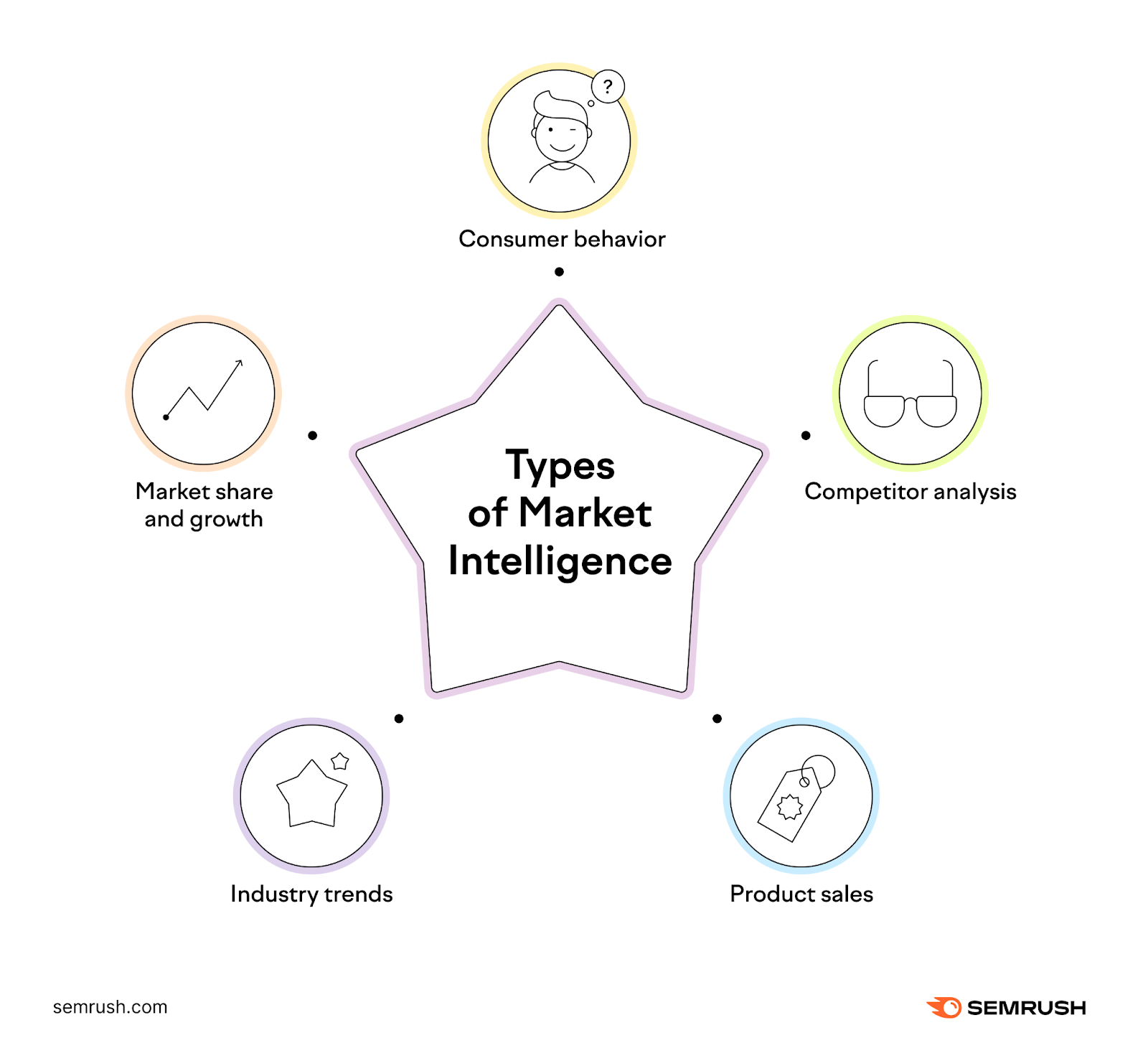
The core goal of gathering market intelligence is to equip businesses with insights that drive strategic decision-making.
Whether a company is launching a new product, penetrating a new market segment, or trying to outsmart competitors, market intelligence can help them make the right decisions.
Companies can gather marketing intelligence data through various means. These can include market research, surveys, interviews, statistics, and reports. And tools like Semrush .Trends and Customer Surveys.
For best results, companies should combine market intelligence with their own expertise and experience. This adds context to the data. Which leads to better insights.
Market Intelligence vs. Business Intelligence
Many people confuse market intelligence with business intelligence. But they aren’t the same thing.
Business intelligence covers company-specific data. Whereas market intelligence takes a broader view.
Business intelligence shows you how your company is performing and where you can improve. It can help you figure out what drives business, where you can cut costs, and where you should invest additional resources to boost revenue.
Market intelligence looks at the bigger picture. It can help you answer key questions, like:
- What do my customers really need?
- What are my competitors doing?
- What are the biggest trends in my industry at the moment?
What Are the Benefits of Market Intelligence?
Marketing intelligence offers a wide range of benefits for any kind of business. It helps you:
- Inform product strategy and messaging: Companies can make decisions based on data-driven insights about customer needs and desires. And use these insights to improve their product range, overall marketing strategy and marketing campaigns.
- Gain a competitive edge: Competitive intelligence sheds light on competitors’ strategies and performance. This enables businesses to identify gaps in the market and differentiate themselves, even in a competitive market.
- Identify emerging trends: Spotting trends early is possible with marketing intelligence. It empowers businesses to adapt to market shifts and capitalize on new opportunities before they become mainstream
- Mitigate risks: Companies can use market intelligence to create market forecasts and predict future customer behavior. This can help them foresee market downturns or shifts in customer demand. So they can adjust their strategies ahead of time.
Let’s walk through an example.
Imagine a beverage company is preparing to launch a new line of herbal teas.
They are wondering what kind of teas to offer (product strategy) and how to talk about them (messaging). So, they dive into data on consumers’ lifestyle habits, beverage preferences, health goals, and budgets.
They realize health benefits and organic ingredients are becoming more important to their millennial target audience (emerging trends).
They use these insights to tailor their flavors, packaging, and marketing messages. And position their herbal teas as the go-to choice for health-conscious consumers.
By doing this, they gain a competitive edge. And they reduce the risk of the product and messaging not resonating with consumers.
How to Gather and Use Market Intelligence
Let’s go through the process of collecting market intelligence data, step by step.
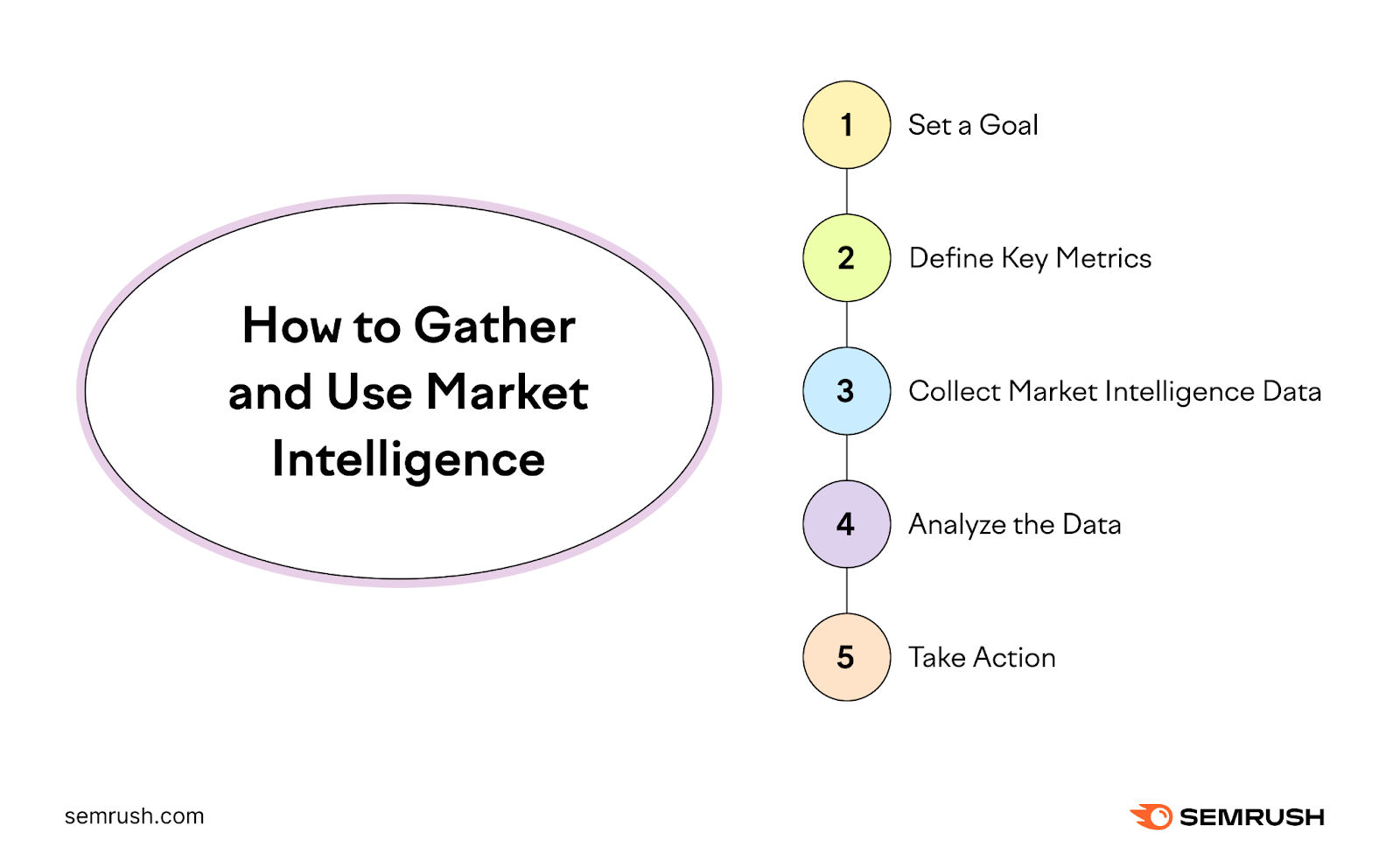
Set a Goal
Start by nailing down what you want to achieve with your market research.
Here are some goals you might consider:
- Understand customer needs
- Benchmark your brand against competitors
- Identify opportunities for new products
- Evaluate customer satisfaction
- Optimize pricing strategies
Define Key Metrics
Next, zoom in on the metrics that make sense for your business.
Defining key metrics is vital because it turns your broad goals into measurable targets. Helping you track progress and make informed decisions.
Here’s a list of example metrics you might consider:
- Customer acquisition cost (CAC): Know how much you’re spending to acquire a new customer
- Customer lifetime value (CLTV): Estimate the total value of a customer to your business over the whole period of your relationship
- Market share: Measure the slice of the market pie you own compared to your competitors
- Top-of-mind scores: Gauge how well people know your brand across your target market
- Net promoter score (NPS): Get a feel for customer loyalty and the likelihood they’ll recommend your business to others
- Sentiment: Do your customers feel positively or negatively about your brand?
- Sales and revenue: Which products are having a positive impact on your bottom line?
- Visits and keyword rank: Digital marketing and SEO metrics can show you how your website content is performing compared to competitors
Further reading: Business Metrics: What They Are & 20 You Should Track
Collect Market Intelligence Data
Now, it’s time to start gathering data. There are a few ways you can do that, depending on your goals and metrics.
You can conduct primary research. This involves gathering new, first-hand data directly from the source—usually consumers in your industry or current customers.
Another option is to conduct secondary research. This means reviewing information that has already been collected, analyzed, and published by others. Like industry reports and studies.
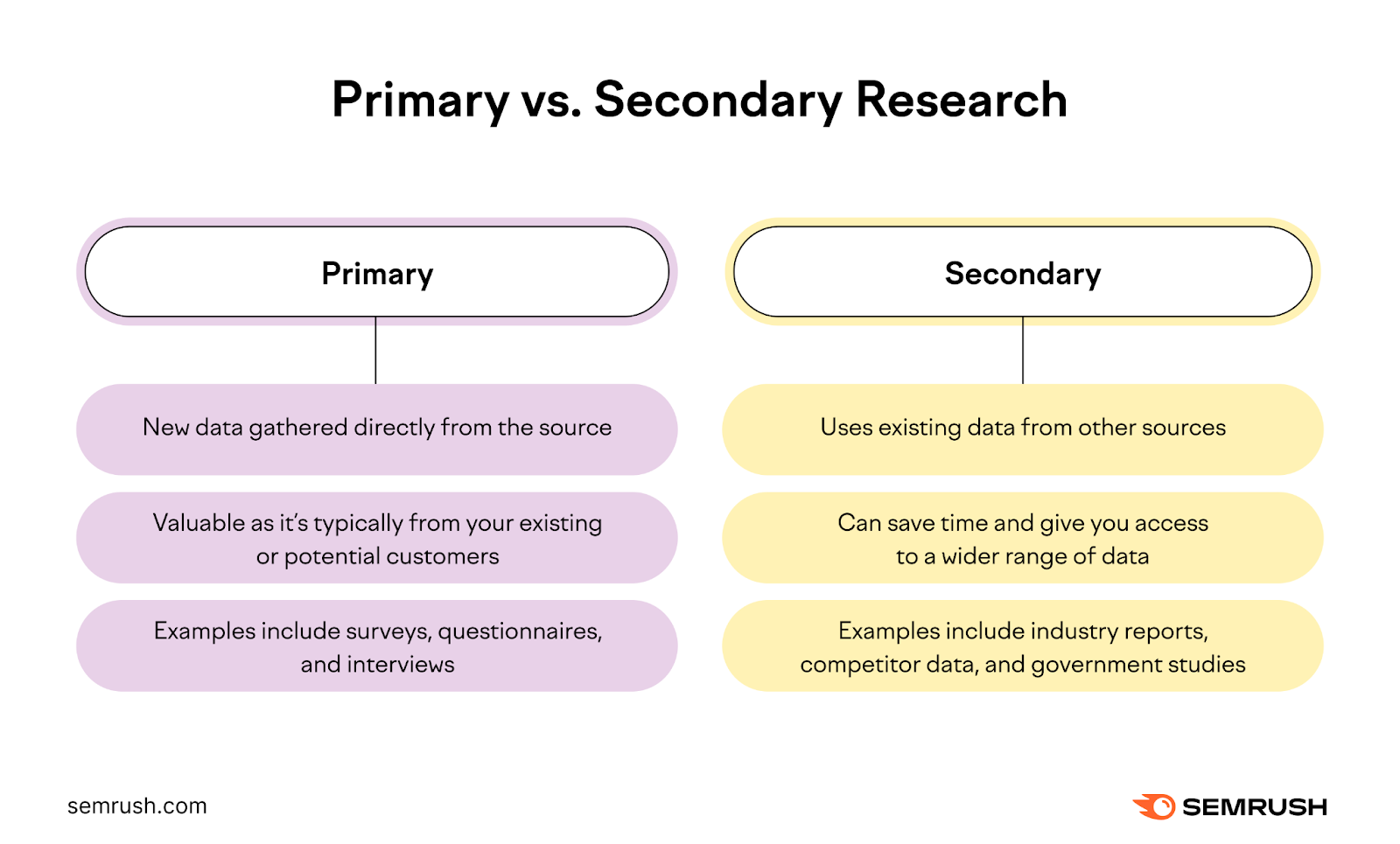
Primary Research Methods for Market Intelligence
Here are the key types of primary research methods:
Surveys and Questionnaires
Want to understand the needs of consumers or current customers? Just ask them.
Running a survey can help you understand shopper preferences, challenges, and perceptions of your brand.
You’ll need to ask the right questions and get enough responses to ensure the data sample is statistically valid.
Interviews
One-on-one interviews offer a deep dive into consumer habits and preferences.
You’ll get qualitative, unstructured data. The advantage is that it goes into more depth than simply ticking “yes” or “no” on a survey. You will get more context on what customers prefer and why.
But it will take more effort to analyze this kind of data, especially at scale.
Focus Groups
Focus groups involve a moderated discussion with selected participants. This method is particularly effective for testing new product concepts, advertising messages, or branding strategies.
The interactive nature of focus groups can uncover a wealth of qualitative data, revealing new perspectives and considerations.
Observation
Observational research involves watching how consumers interact with products in a natural setting, typically a store or supermarket.
This method shows how customers choose products in real life, which features attract attention, and what motivates or dissuades them from buying.
Observational data is helpful for informing product design adjustments, optimizing retail layouts, and developing marketing tactics that align with actual consumer behavior.
Product Testing
Offering sample products to a segment of your target market allows for direct feedback on taste (if relevant), functionality, design, and customer experience.
The process can identify flaws, gauge customer satisfaction, and even generate early buzz before a product hits the broader market.
Product testing also often leads to meaningful customer engagement and loyalty, as users feel their input is valued in the product development process.
Other Sources of Data
You can (and should) also examine customer data in your database or customer relationship management tool. This can help you identify buying patterns and understand the behavior of your existing customers.
Secondary Research Methods for Market Intelligence
Secondary research is typically more straightforward than primary research. Because you’re using information that is already available.
However, the insights are usually more limited. Here are some of the most common methods:
- Industry reports: This includes market analysis data from research firms, universities, academic institutions, consulting companies, industry publications, and more
- Competitor data: This is data that competitors have disclosed publicly, such as annual reports, investor relations materials, and press releases
- Government and NGO statistics: Data from government agencies and NGOs reveal macroeconomic indicators, regulatory changes, and social trends
After you’ve collected the information you need, the next step involves analyzing it to understand the most important insights.
Analyze Market Intelligence Data
Market intelligence is about more than just collecting data—you also need to understand it. You need to take that raw data, analyze it, and turn it into actionable insights to direct your business strategy.
Here’s a four-step approach to make that happen:
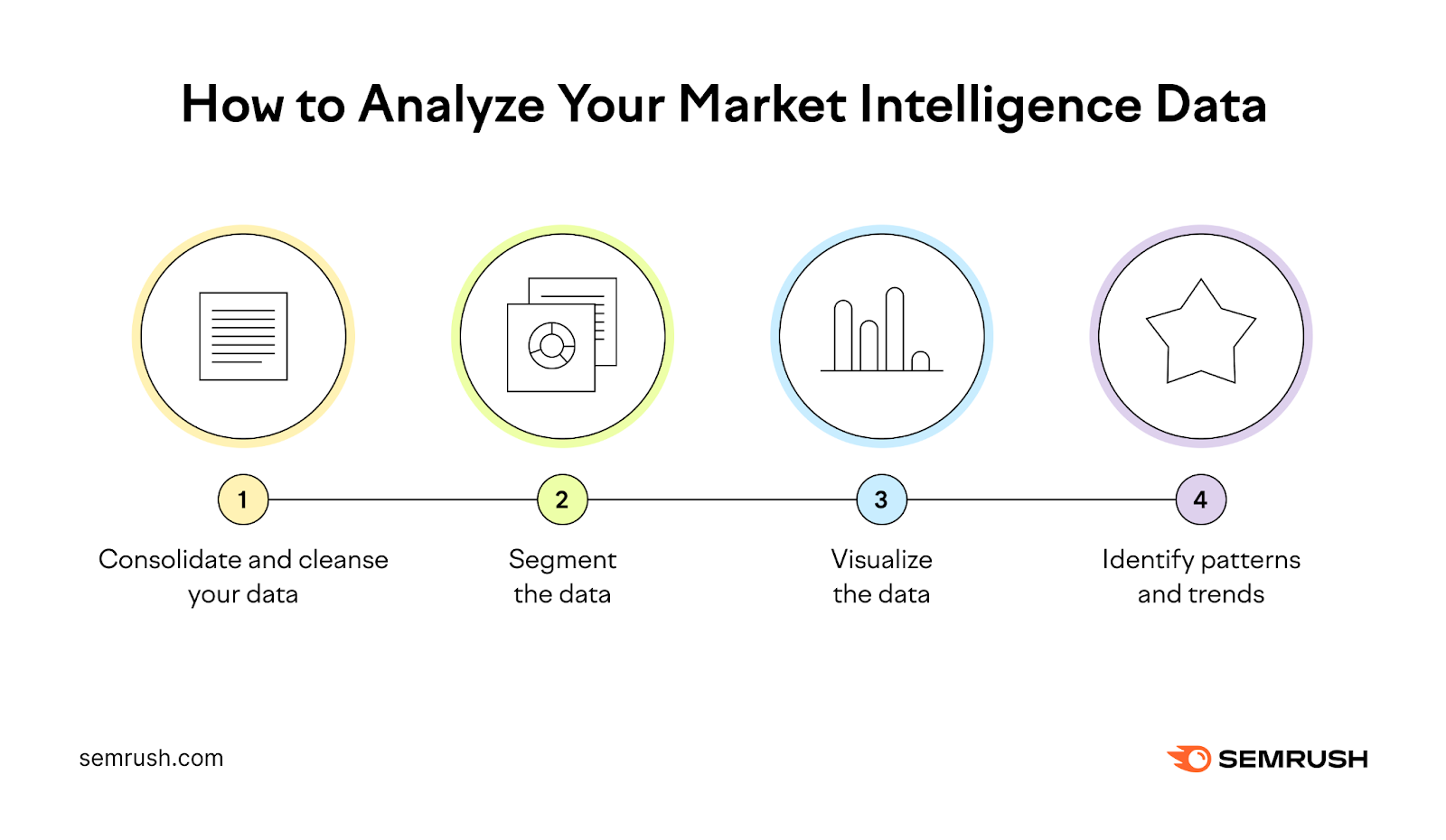
- Consolidate and cleanse your data: Start by consolidating all your data sources into one place. This might involve combining survey results, sales data, and competitor information. Make sure to clean this data, removing any duplicates or errors that could skew your analysis.
- Segment the data: Break down your data into segments. This means splitting the data based on different customer groups, regions, or product lines. Segmentation can help you understand specific consumer demographics in more detail.
- Visualize the data: By presenting your data in a graph or chart, you can more easily spot the trends and insights that matter. Tools like Microsoft Excel or Google Sheets can help with this. Visualizations also make it easier to communicate your findings to others.
- Identify patterns and trends: Look for patterns or trends that emerge over time or across different market segments. Are there spikes in purchase behaviors around certain times of the year? Does a particular customer demographic show a preference for a specific product?
Take Action Based on Insights
After gathering and visualizing your market intelligence, share actionable insights with key stakeholders in your company. Present your findings in a way that highlights the opportunities, challenges, and next best actions.
Whether it’s refining your marketing strategy, tweaking product features, or entering new markets, the steps you take can lead to significant competitive advantages and growth for your business.
Top Market Intelligence Tools
There are many tools available to support your market intelligence efforts. Here is an overview of some of the most useful market intelligence tools:
Semrush .Trends
Semrush .Trends is a leading market intelligence tool. It helps you identify trends and competitive insights across 190 countries.
With Semrush .Trends, you can unlock new areas for market expansion, prioritize high-impact channels for business growth, and drive your marketing strategies with insights to boost ROI.
Semrush .Trends includes Market Explorer and Traffic Analytics. Let’s take a look at these tools in more detail.
Traffic Analytics
Semrush’s Traffic Analytics provides a comprehensive performance review of any website. It breaks down the data by acquisition channel, such as direct, referral, search, social, and paid traffic.
To get started, type in your competitor’s URL and hit “Search.”
You’ll see an overview of digital marketing key performance indicators (KPIs) like visits, unique visitors, pages per visit, and average visit duration. If you scroll down, you can see how the number of visits has changed over time. It also shows you their main sources of traffic.
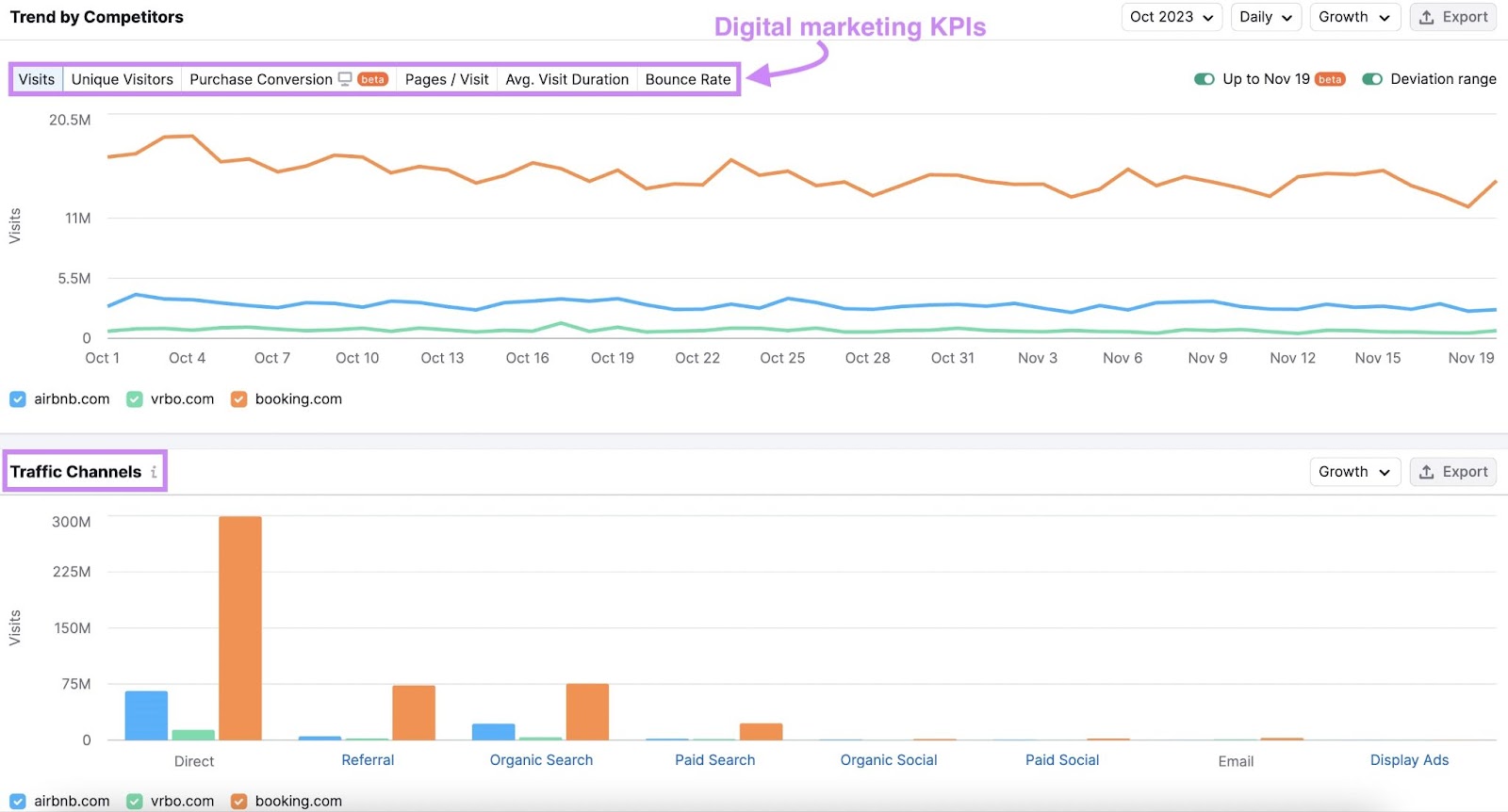
Below, you’ll see the main countries their traffic is coming from. And company data like funding they’ve received and the number of employees.
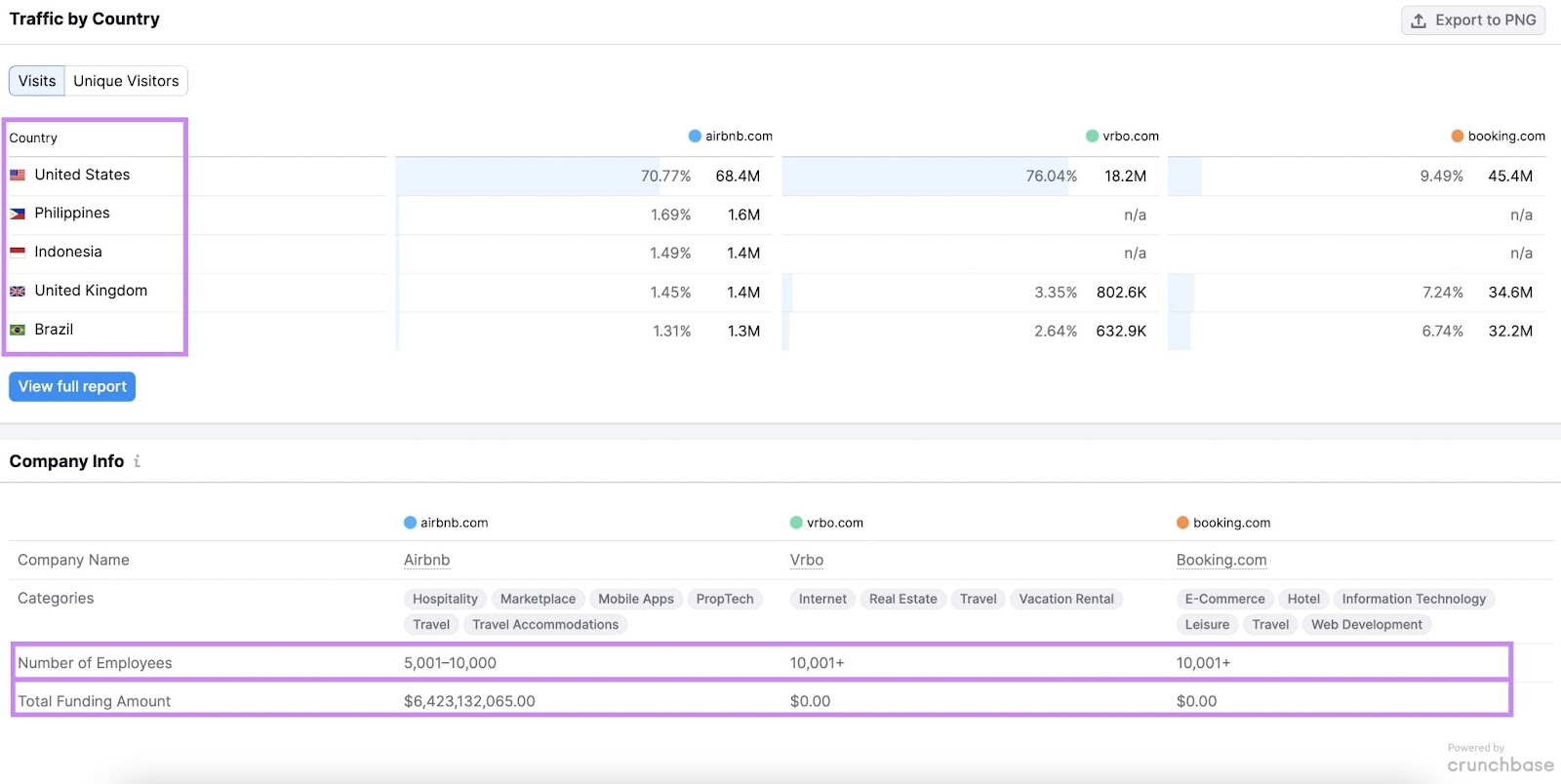
At the top, you can click the “Audience Overview” tab to gain a better understanding of the target market.
You’ll see demographic data like age, gender, and location. And socioeconomic data like household size, income level, employment status, and education level.
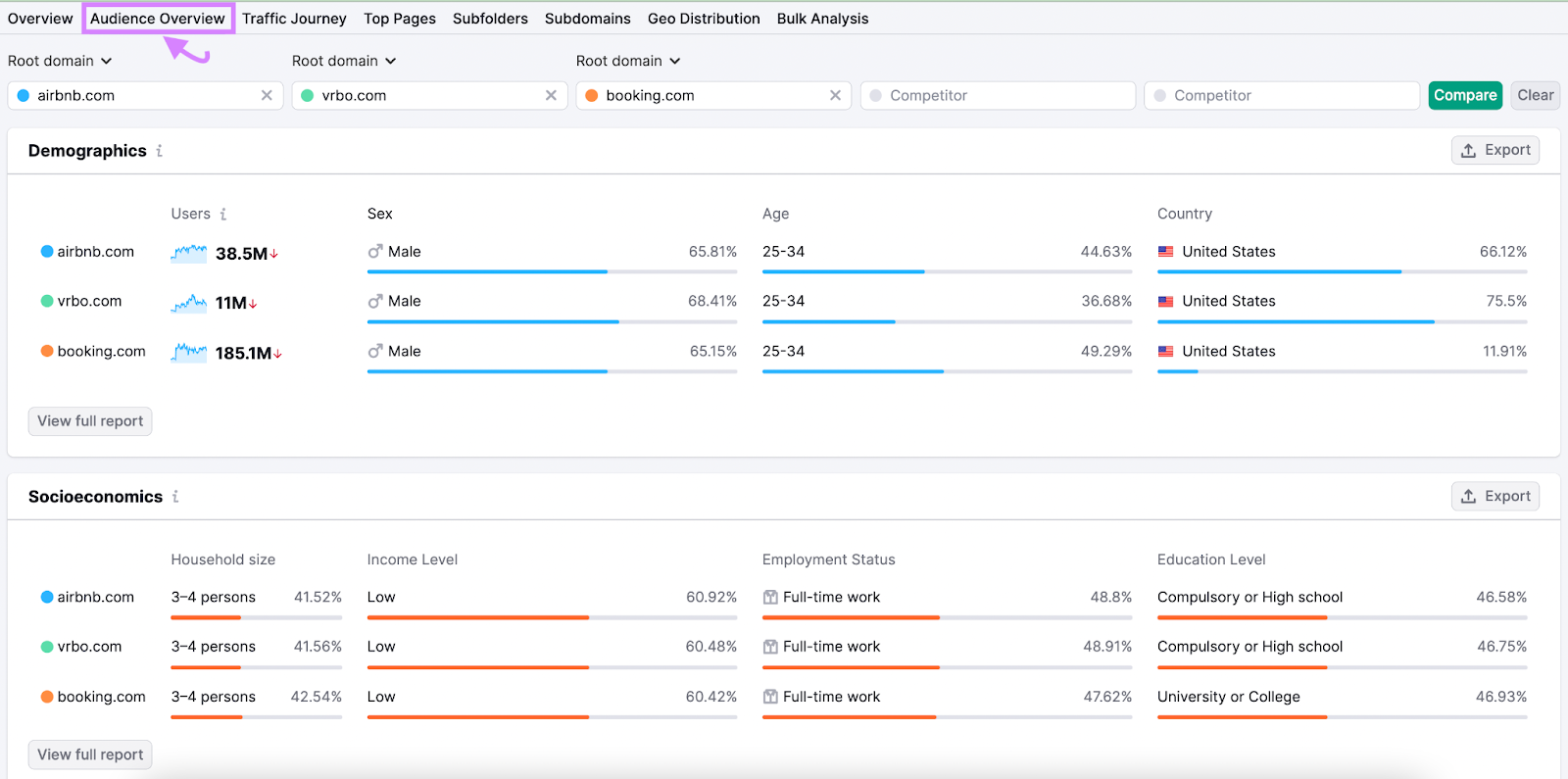
This gives you a better understanding of your competitors’ customers. This can help you target them with the right messaging and pricing strategies.
Market Explorer
Semrush’s Market Explorer gives you a comprehensive overview of your market and its key players.
To get started, type your URL or the URL of any competitor and hit “Search.”
At the top, you’ll find a market summary with an overview of the key players and their market share.
Below, the growth quadrant shows you which competitors are niche players, game changers, leaders, or established.
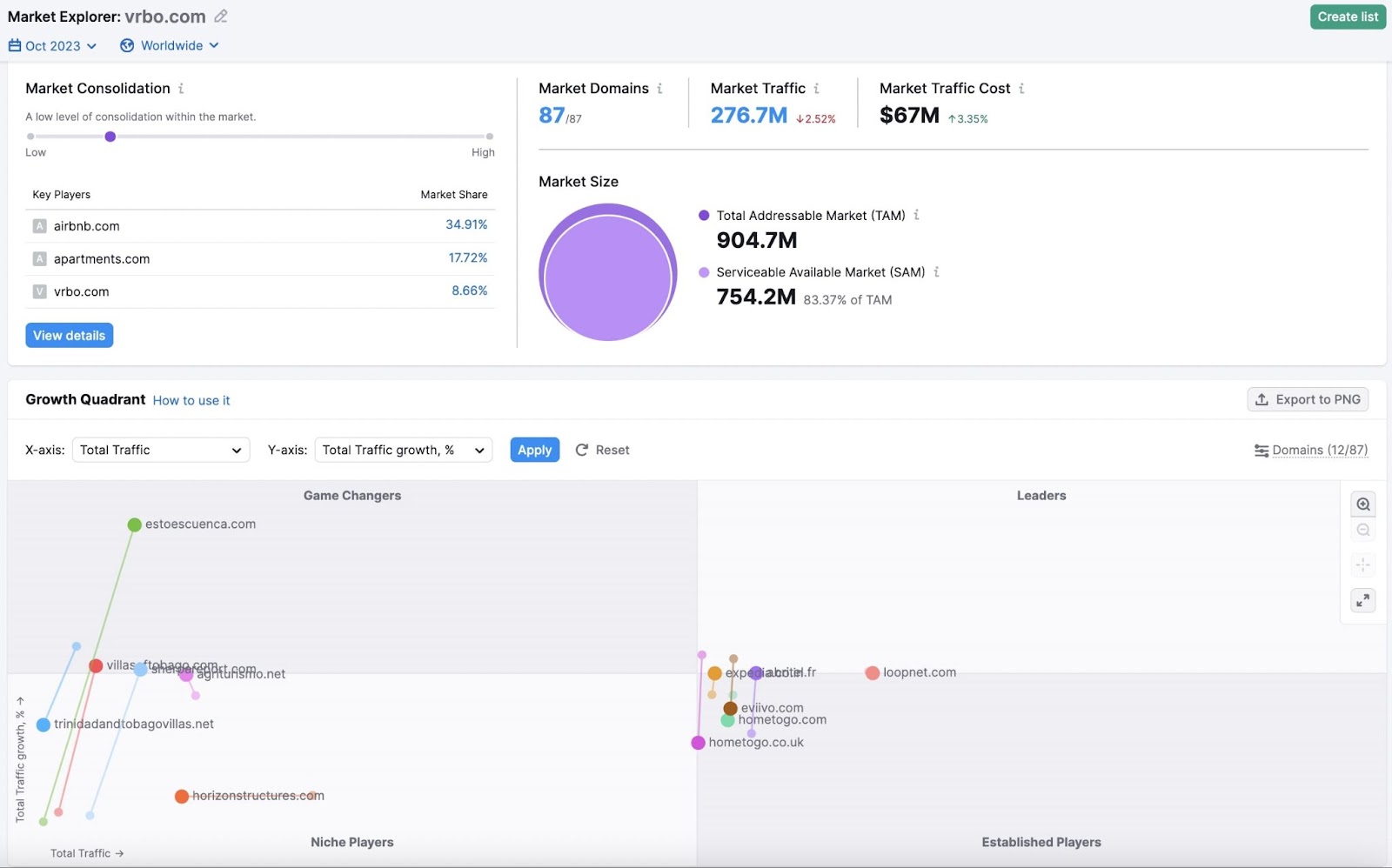
AdClarity
Semrush’s AdClarity is a powerful competitive intelligence tool. It is designed to give marketers an edge by providing insights into their competitors’ advertising strategies.
Select a free trial and add a competitor’s domain.

Your competitor’s advertising data is displayed using graphs, charts, and tables.
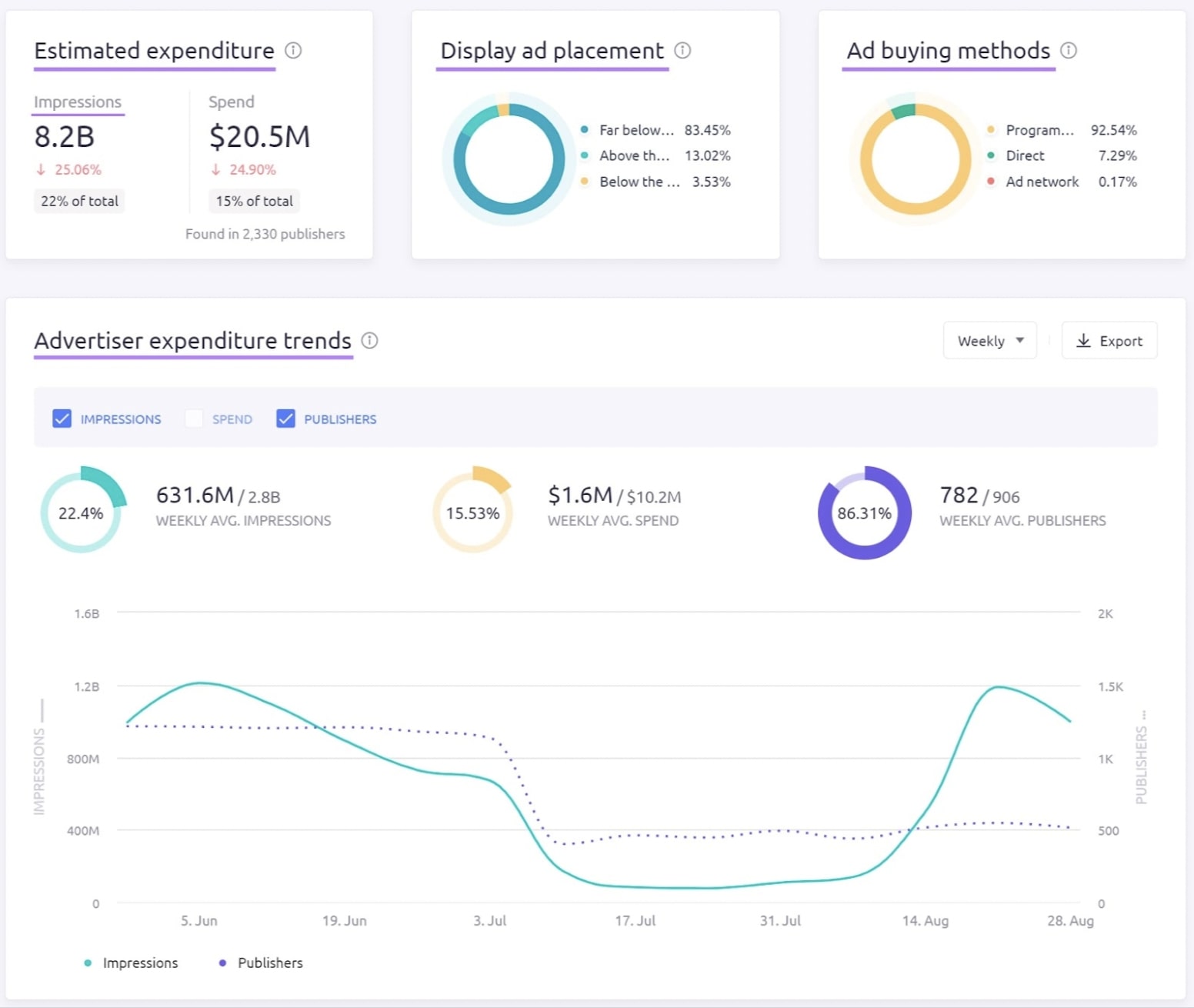
You can use AdClarity to:
- Uncover your competitors’ messaging and visuals—and check the results
- Identify your competitors’ best-performing campaigns, top ads, and traffic sources
- Improve the reach and performance of your own campaigns
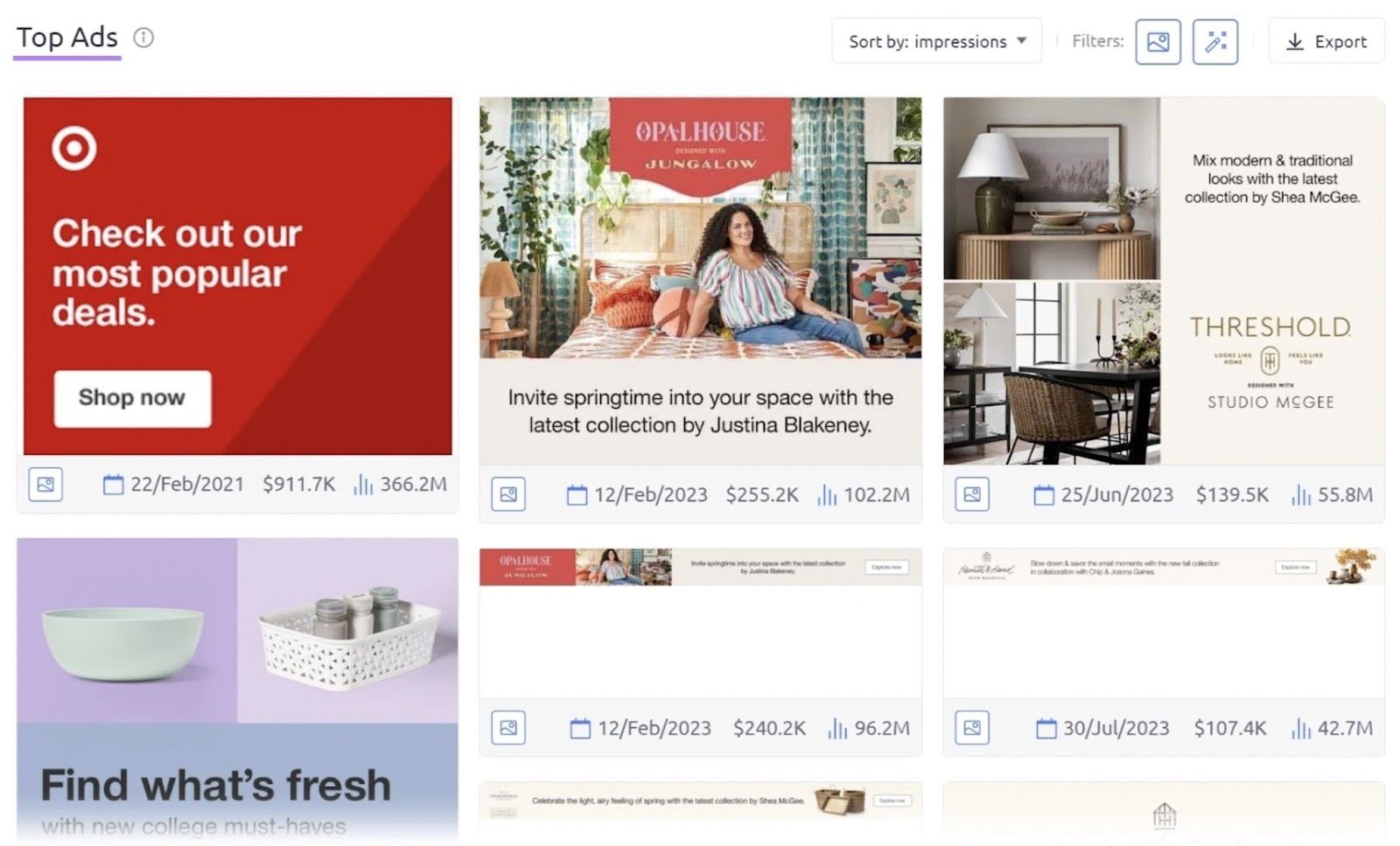
Audience Intelligence
Audience Intelligence from Semrush enables you to gain a better understanding of your target market. And learn more about your competitors’ customers. Its insights are based on traditional analytics and social media data.
To get the insights, just type in the @handle of the brand or account you want to explore. Then, you’ll see the demographics of their followers. You’ll also see other brands they follow, top influencers, and content sources.
Like this:
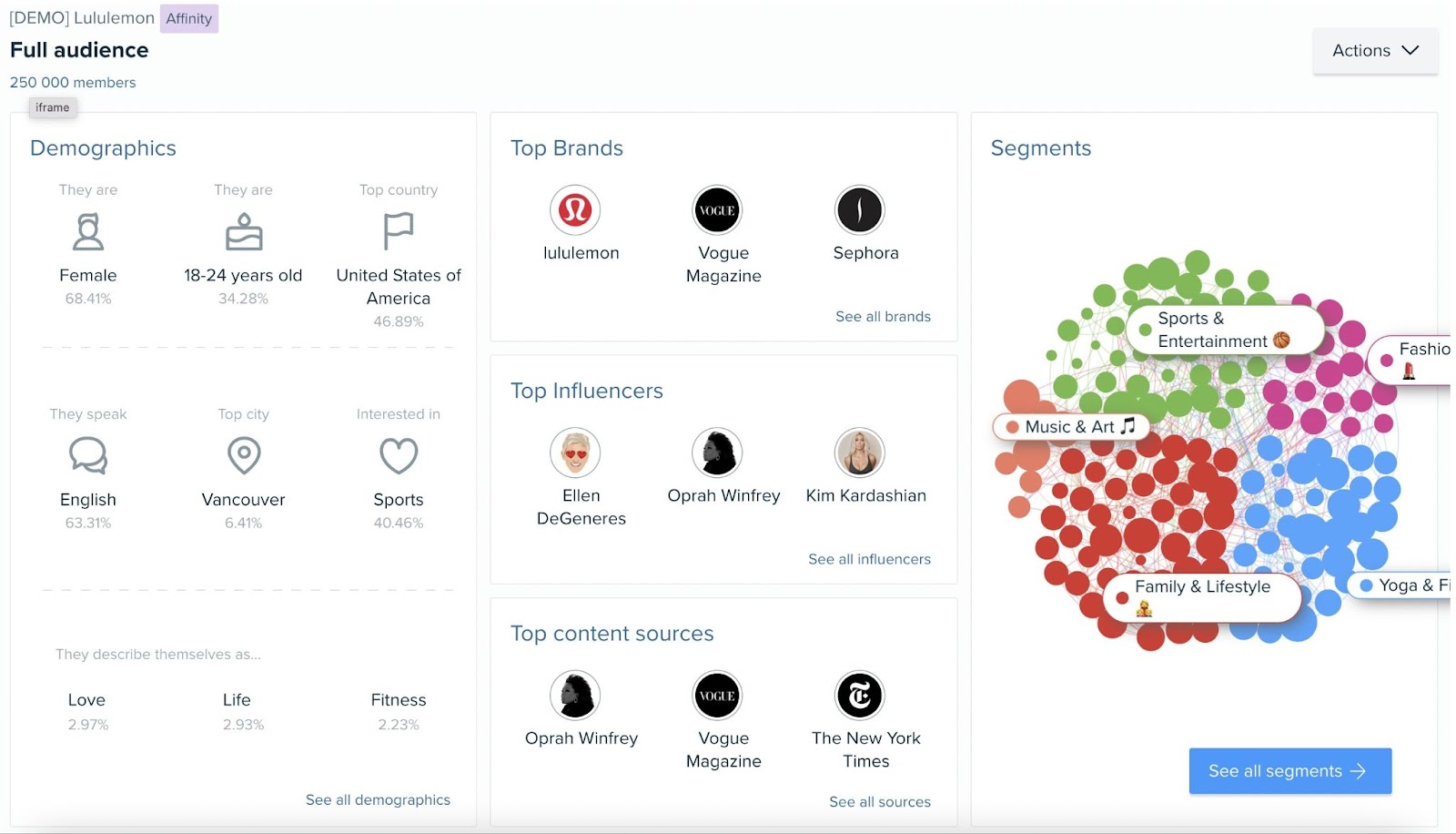
Consumer Surveys
Consumer Surveys, found in the Semrush App Center, enables you to run and analyze market research surveys.
You can glean insights from pre-existing surveys that are updated monthly. Or you can run your own custom surveys and get thousands of responses from real, verified users.
The pre-existing surveys cover key topics like entertainment, health, home, shopping, and technology. Like this one about customer attitudes toward healthy eating:
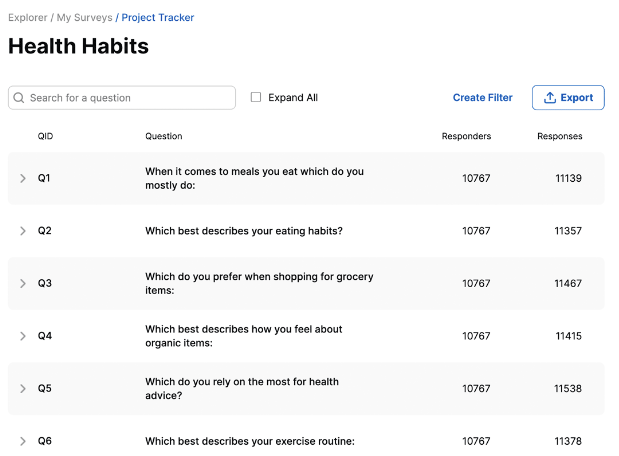
You can also request custom surveys specific to your industry or brand. Just click “Request a survey” and fill in some basic details:
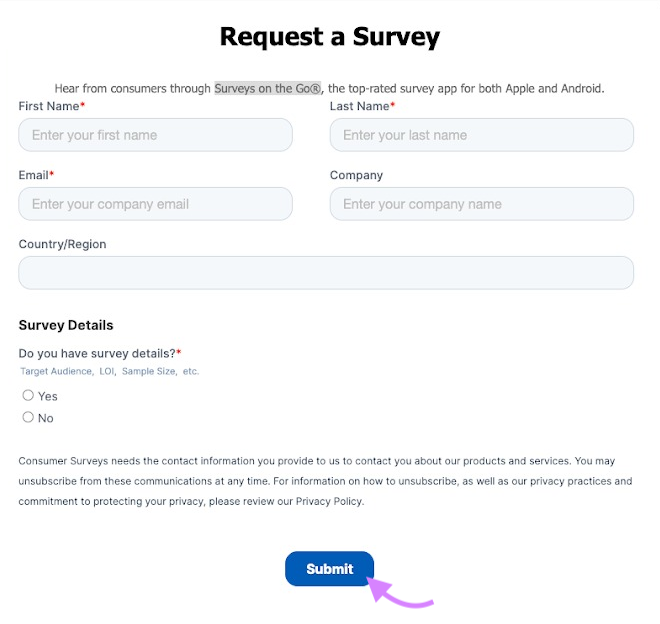
Once the responses are in, it’s easy to analyze the results. For example, you can choose a question and filter it by age, gender, income level, and more to see how different demographics responded.
Keyword Gap for Search Engine Market Intelligence
Which keywords are your competitors ranking for? Is their SEO strategy more effective than yours? Search engine marketing intelligence can help you find out.
To get started, open Semrush’s Keyword Gap tool.
Next, enter your domain and up to four of your competitors’ domains. Then, hit “Compare.”
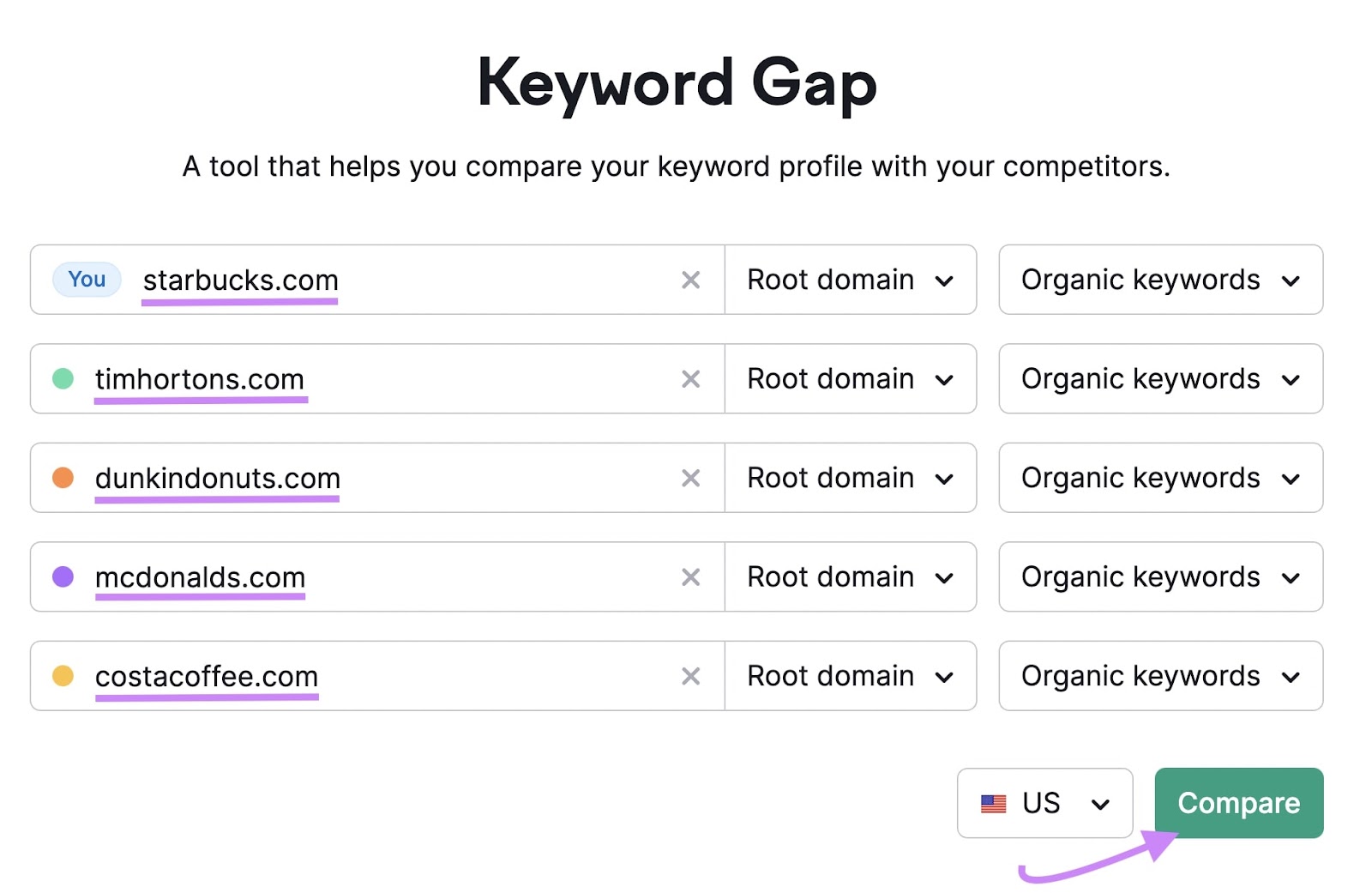
If you scroll down, you’ll see a list of keywords that you and your competitors rank for:
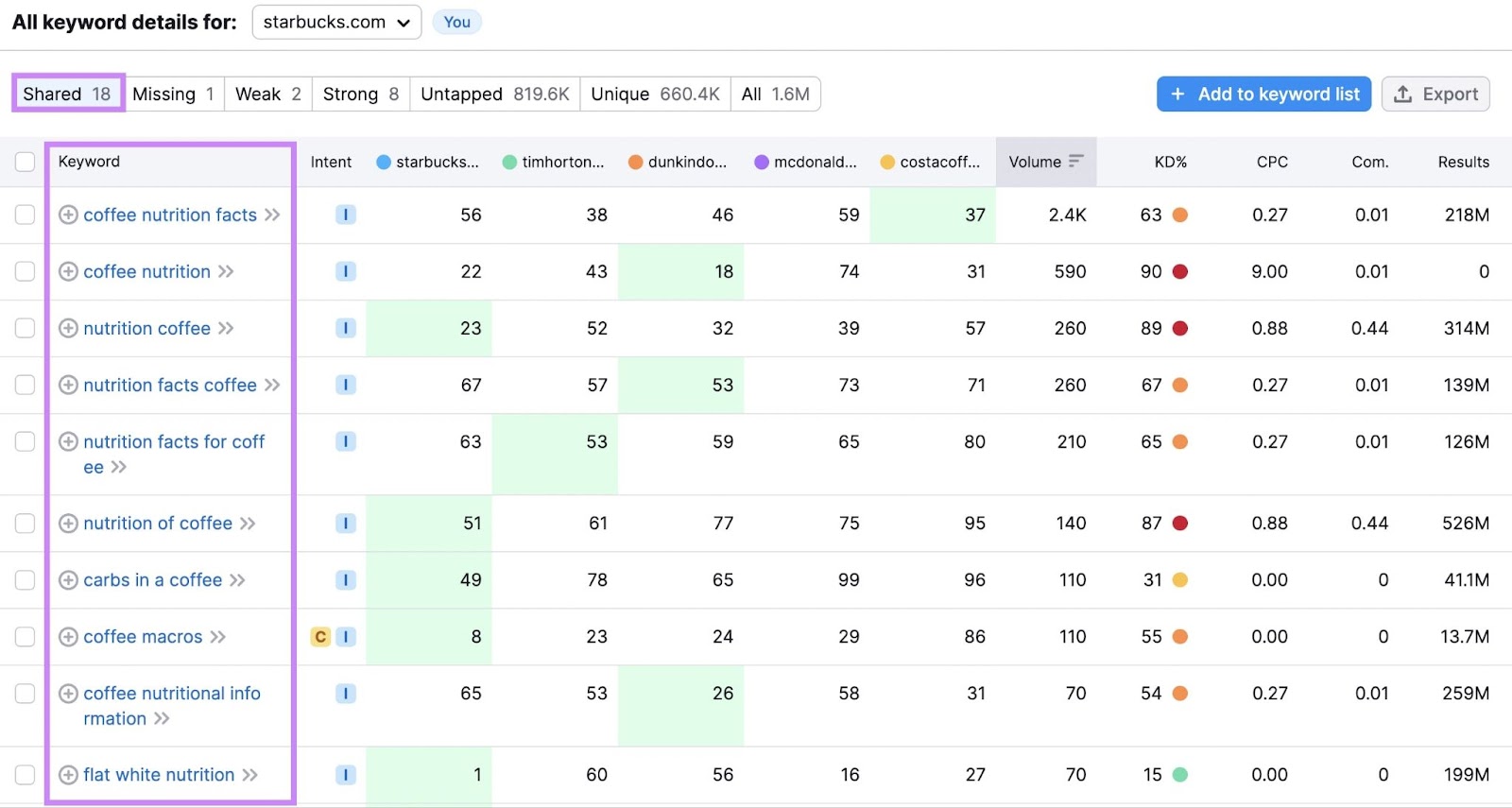
You can click “Missing” to find the keywords your competitors rank for that you don’t:
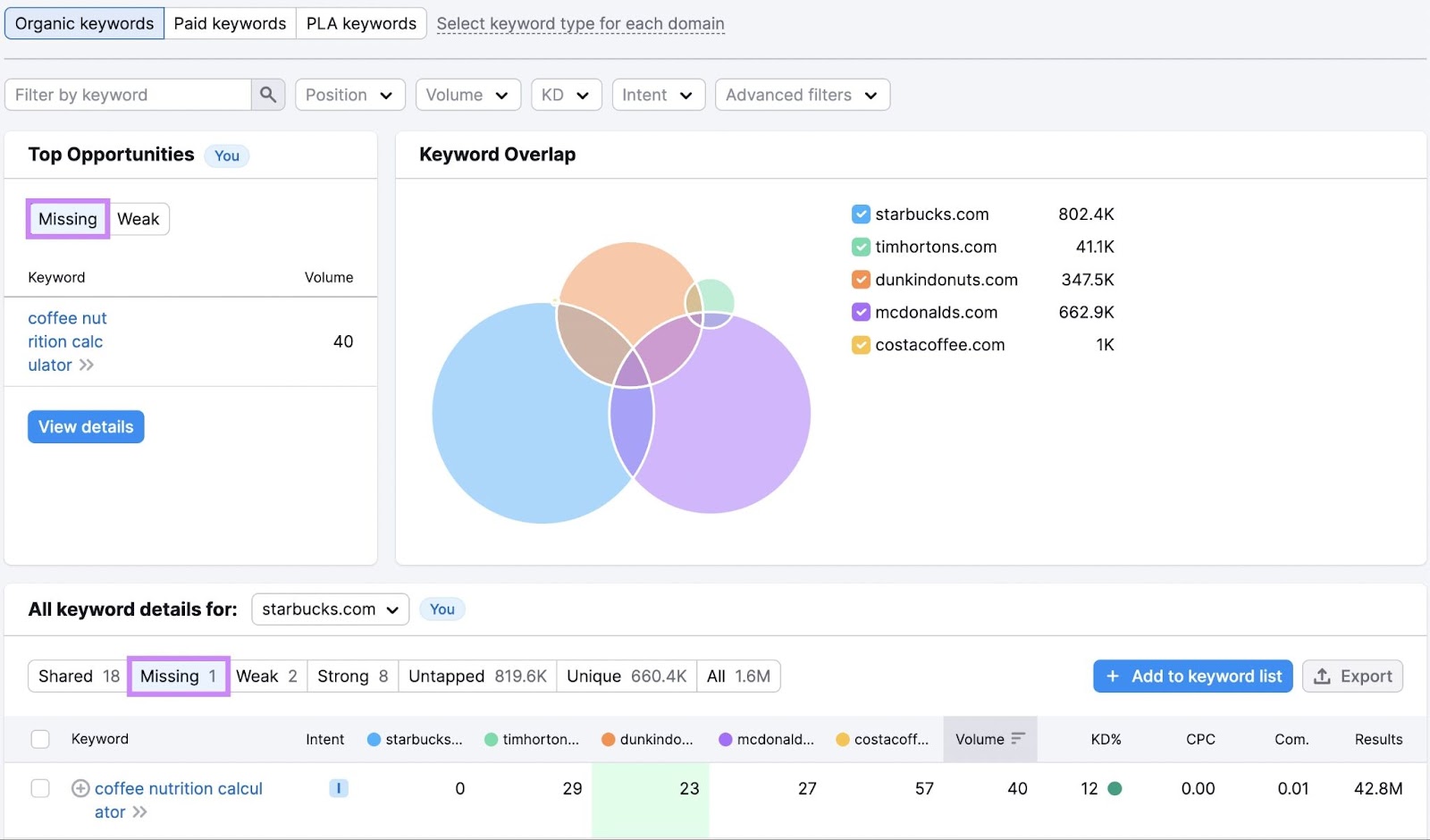
You can use your competitors’ keyword performance to benchmark your own SEO performance. And review their keywords to find inspiration for your content strategy.
G2 Crowd
G2 Crowd draws from the popular reviews website G2. It can help you identify competitors and understand the competitive landscape within a chosen category.
You can search by industry or company name to see an overview of top players and their products.
It then shows you customer reviews and alternatives for each company:
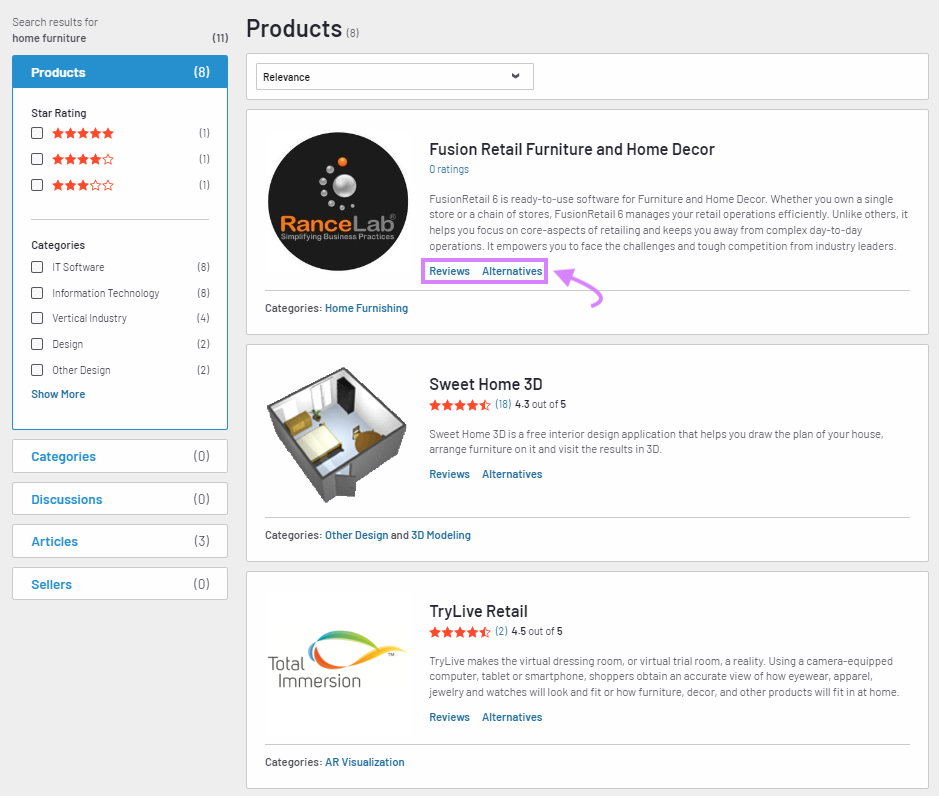
With G2 Crowd, you gain key insights into your competitors, their products, and what consumers think about them.
Wappalyzer
Wappalyzer tells you which tools competitors are using on their websites.
It can detect content management systems, ecommerce platforms, analytics tools, advertising networks, and a lot more.
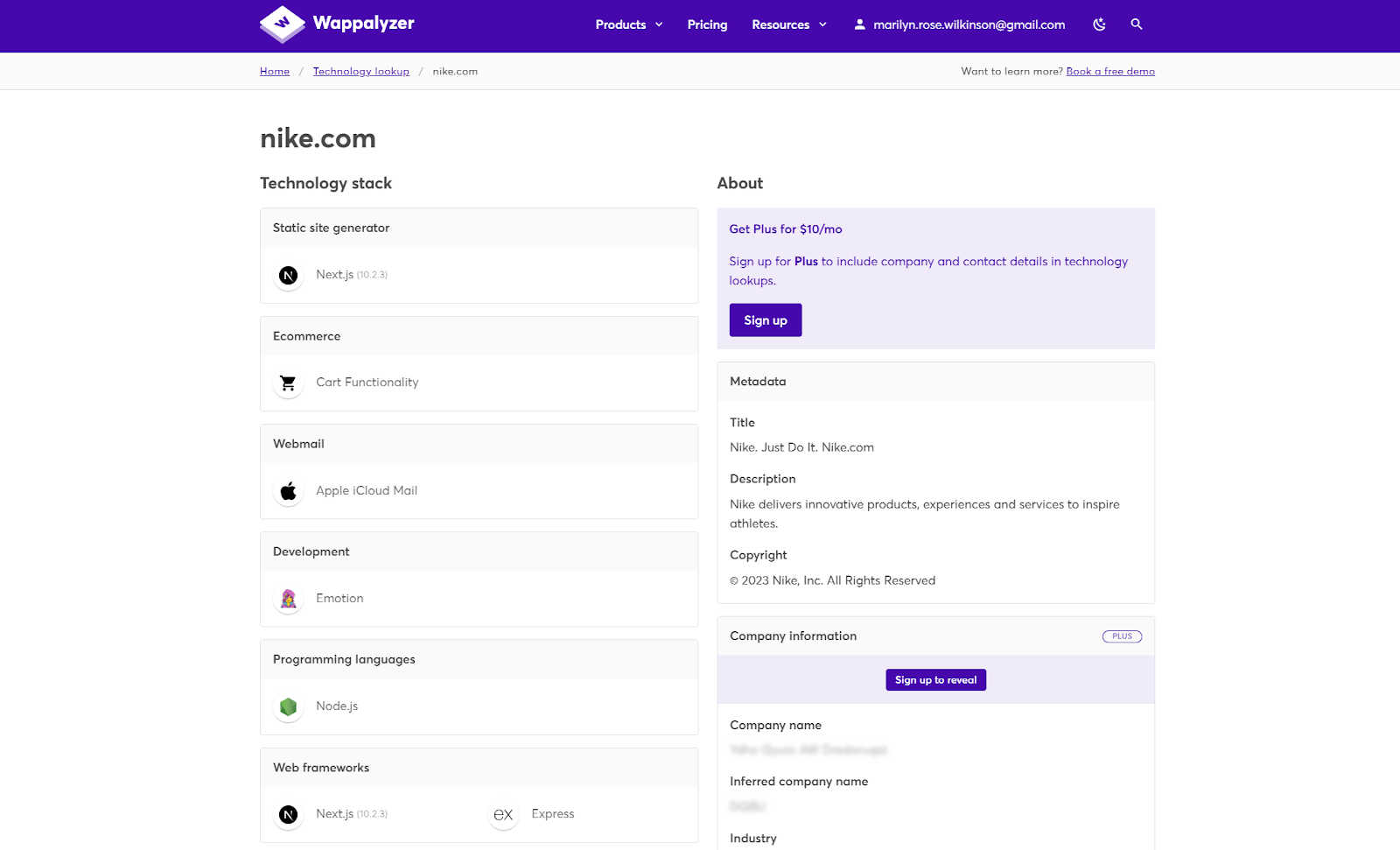
You can use these insights to understand how well-equipped the competition is. And make decisions about your own tech stack.
Social Searcher
Social Searcher is a free social media search engine. It shows trends and topics of interest related to your industry.
You can search for keywords, mentions, users, and trends:
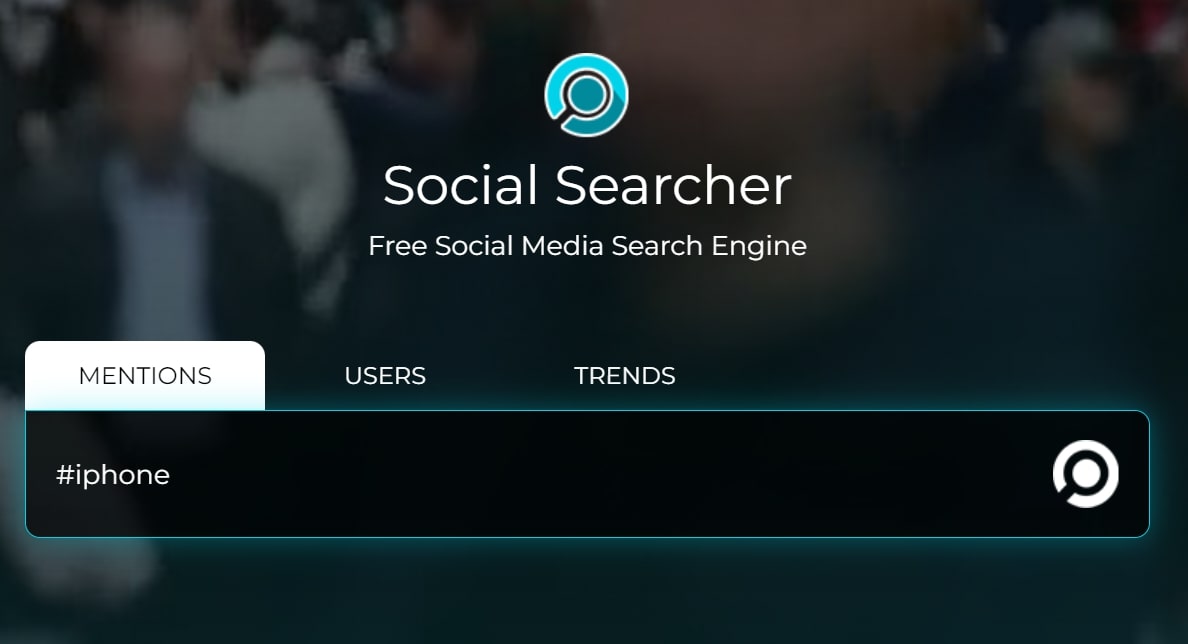
This helps you track user sentiment and understand how consumers are thinking and feeling. You can even use it to find what people are saying about your brand.
Revolutionize Your Business Landscape with Market Intelligence
Market intelligence has the power to drive meaningful change and help you make better business decisions.
By harnessing the deep insights provided by market intelligence tools, businesses can navigate the complexities of their market with confidence.
Take the first step in transforming your business’s future by signing up for a free trial of Semrush .Trends. Unlock the potential of data-driven decisions and experience how an informed strategy can empower your brand to lead and innovate.
